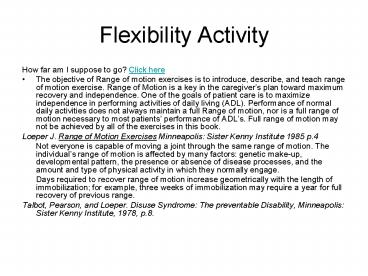Flexibility Activity - PowerPoint PPT Presentation
1 / 11
Title:
Flexibility Activity
Description:
Flexibility Activity How far am I suppose to go? Click here The objective of Range of motion exercises is to introduce, describe, and teach range of motion exercise. – PowerPoint PPT presentation
Number of Views:56
Avg rating:3.0/5.0
Title: Flexibility Activity
1
Flexibility Activity
- How far am I suppose to go? Click here
- The objective of Range of motion exercises is to
introduce, describe, and teach range of motion
exercise. Range of Motion is a key in the
caregivers plan toward maximum recovery and
independence. One of the goals of patient care is
to maximize independence in performing activities
of daily living (ADL). Performance of normal
daily activities does not always maintain a full
Range of motion, nor is a full range of motion
necessary to most patients performance of ADLs.
Full range of motion may not be achieved by all
of the exercises in this book. - Loeper J. Range of Motion Exercises Minneapolis
Sister Kenny Institute 1985 p.4 - Not everyone is capable of moving a joint
through the same range of motion. The
individuals range of motion is affected by many
factors genetic make-up, developmental pattern,
the presence or absence of disease processes, and
the amount and type of physical activity in which
they normally engage. - Days required to recover range of motion
increase geometrically with the length of
immobilization for example, three weeks of
immobilization may require a year for full
recovery of previous range. - Talbot, Pearson, and Loeper. Disuse Syndrome The
preventable Disability, Minneapolis Sister Kenny
Institute, 1978, p.8.
2
How to
- Line of Pull
- Vs
- Spread the Wealth
3
Joint Play
4
Mechanical and Dynamic Properties of Soft Tissues
- Elasticity, Hookes Law and states that there is
a constant or proportional arithmetical
relationship between force and elongation. The
elastic element must have full recovery and
regain its exact original dimensions from the
deformation - Plasticity is the property of a material to
permanently deform when it is loaded beyond its
elastic range (e.g.modeling clay) - Viscosity is the property of materials to
resist loads that produce shear and flow
5
Mechanical and Dynamic Properties of Soft Tissues
cont
- Most biological materials are neither perfectly
elastic nor perfectly plastic, they exhibit a
combination of properties referred to as
Viscoelasticity - Hysteresis is a phenomenon associated with energy
loss exhibited by viscoelastic materials when
they are subjected to loading and unloading cycles
6
- When a resting muscle is suddenly stretched and
held at a constant length, after a period of time
there is a slow loss of tension
stress-relaxation - In contrast the lengthening that occurs when a
constant force or load is applied is called creep
7
Methods of facilitating muscular relaxation
- Static
- PNF
- Massage
- Manipulation
- Heat
- Cold
- Meridian Trigger Points
- Breathing and patterns
- Eye positioning
8
- Ballistic
- Active
- Passive
- PNF
- Muscle energy techniques
- Similar to methods of PNF, however 20-25 effort
- A new one
9
Types and Varieties of StretchingProprioceptive
Neuromuscular Facilitation types
- Repeated contractions RC isotonic agonistic
fatigue - Rhythmic Initiation RI relax/passive/contract
- Slow reversal SR isotonic antagonists/agonists
- Slow reversal hold SRH - isotonic antagonists/
isometric agonists - Rhythmic Stabilization RG isometric
agonist/isometric antagonist - Contract-Relax CR max isotonic antagonist
(w/resistance) / passive stretch - Contract-Relax agonist contract CRAC CR plus
agonist con. contracted - Hold-Relax HR isometric antagonist / active
stretch - Slow reversal-Hold-Relax SRHR isotonic
antagonist isometric antagonist /relax/isotonic
agonist - Agonistic Reversal AR isotonic ROM w/resistance
/ ecc./con. repeats
10
Swiss Ball
- Why?
- Stability
- Range of motion
11
Basic Positions
- Table top
- Hip Extension
- Seated































